Housed within Quisqueya University, the Cultural Conservation Center serves as the country’s only art restoration center
The Cultural Conservation Center (Centre de conservation des bien culturels) at Quisqueya University (CCC-uniQ) was inaugurated in 2015. It emerged from the Cultural Recovery Center (CSBC), a structure established after the January 12, 2010 earthquake as part of an extensive Cultural Recovery Project for Haiti initiated by the Smithsonian Institution in collaboration with the Haitian government, and numerous local and international partners. This project saved and restored thousands of artworks damaged during the earthquake.
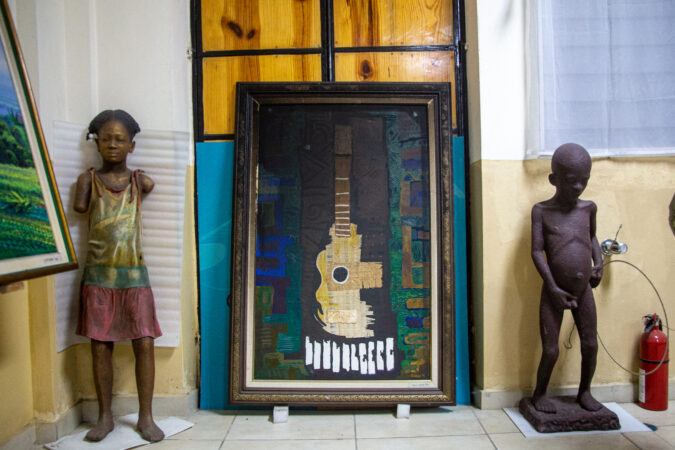
Preserved sculptures and paintings undergoing restoration at CCC-uniQ | © David Lorens Mentor/AyiboPost
Housed within Quisqueya University, the CCC-uniQ is the only art restoration center in the country. It agreed to carry on the legacy of the CSBC as a space for conservation and restoration, where artworks that are part of Haiti’s visual heritage continue to get a second life.
Erntz Jeudy, the Chief Restorer-Conservator of the CCC-uniQ, reflects on the initial moments that brought the institution to life: « The Cultural Recovery Center (CSBC) was located on the road to Bourdon in Port-au-Prince, under the leadership of Mr. Olsen Jean Julien, and subsequently the CCC-uniQ was established to continue the cultural conservation actions that CSBC started. Because CSBC was established as part of a recovery project, it had to close its doors so that we could start afresh on new foundations. »
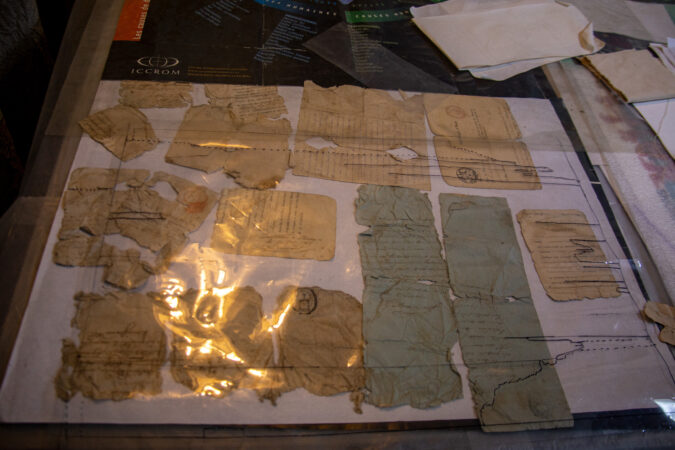
Birth certificate of an elderly Haitian woman being restored. | © David Lorens Mentor/AyiboPost
The Smithsonian Institution, the initiator of this mega-project in 2010, is a complex that comprises seventeen museums, a national zoo, art galleries, and research centers. The institution was established in 1846 by the United States Congress, following a bequest of £100,000 from English chemist and mineralogist James Smithson in 1826 to an American institution aimed at the dissemination of scientific knowledge.
In 2010, this recovery project was developed under the leadership of Richard Kurin, who, leveraging the Smithsonian’s networks, reached out to various institutions and organizations working in the arts and culture sector, as well as conservation specialists in the United States and around the world, to establish a project for safeguarding Haitian cultural heritage.
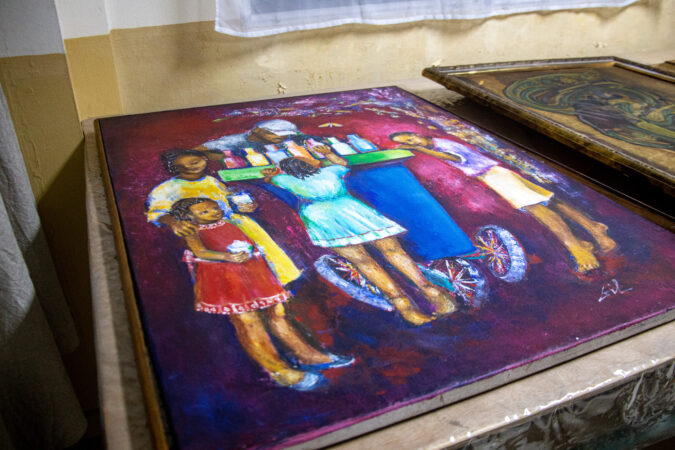
Painting by the artist Gil vandalized during the attack on the Jamaican Consulate in Haiti in June 2023. | © David Lorens Mentor/AyiboPost
The project aimed to both safeguard endangered Haitian heritage, and to train individuals and develop their conservation skills to equip them to protect Haiti’s heritage in the future.
At the time, Richard Kurin was the Under Secretary for History, Art, and Culture and was in charge of most of the national museums, cultural programs, and research centers, including the Center for Folklife and Cultural Heritage (CFCH) at the Smithsonian.
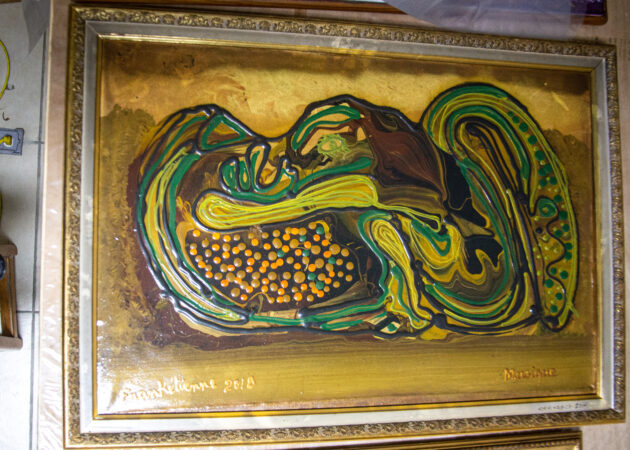
Painting by the artist Frankétienne vandalized during the attack on the Jamaican Consulate in Haiti in June 2023. | © David Lorens Mentor/AyiboPost
This Haitian cultural heritage recovery project wasn’t the first collaboration between the Smithsonian Institution and Haitian cultural actors. In 2004, Richard Kurin, through the Smithsonian’s Folklife Festival titled « 2004 Haiti: Freedom and Creativity from the Mountains to the Sea, » celebrated the bicentennial of Haitian Independence. The event brought together nearly a hundred Haitian artists on the National Mall in Washington, DC.
In 2012, Richard Kurin, through a grant from the Smithsonian Institution, enabled two renowned Haitian artists, Franck Louissaint and Jean Ménard Derenoncourt, to undergo a month-long internship to study and document pictorial works, their production processes, and their treatments. In 2014, Erntz Jeudy and Racine Joseph were received at the Institute for the Preservation of Cultural Heritage (ICPH). Said partnerships with Yale University and the Smithsonian sought to enhance these actors’ skills in preventive conservation, curative conservation, and restoration.
Among the pieces, the interns worked on the restoration of a series of 19th-century portraits by Haitian artist, Louis Rigaud, that are part of the Peabody Museum of Natural History’s collection.

Toussaint L’Ouverture | Artist : Louis Rigaud | Exhibited at the World Cotton Exposition, New Orleans, 1885; sold to the Smithsonian Institution, Washington, D.C.; exchanged with the Peabody Museum, New Haven, Connecticut.
The Smithsonian acquired these paintings in 1885 following the World Cotton Centennial in New Orleans and in 1963. It donated them to the Yale Peabody Museum, where they are displayed.
The presence of Haitian culture is very prominent within the Smithsonian, with a series of archives on Haitian arts in their museums and collections.
The Haiti Cultural Recovery Project, through interventions by the CSBC, has saved nearly 5,000 artworks from the Center for the Arts (Centre d’Art) collection, as well as works from MUPANAH and a portion of the murals from the Holy Trinity Cathedral, featuring frescoes by several Haitian naïve painters like Philomé Obin, Castera Bazile, Wilson Bigaud, and more.
Today, the CCC-uniQ continues the work of conservation and restoration. The interventions are divided into two main categories: one addressing normal situations and another focusing on crisis situations.
Under normal circumstances, restorer Erntz Jeudy explains that CCC-uniQ responds to requests from institutions for conservation-restoration services of cultural assets. They also collaborate with other institutions to identify important works in the country’s cultural heritage that are threatened and propose treatment projects to the owners of these cultural assets. As part of the university’s civic action, CCC-uniQ is currently treating the painting « Assumption of Our Lady of Good Help » for the Cathedral of Cap-Haïtien and has enabled the South branch of the National Confederation of Haitian Practitioners of Vodou (KNVA-Sud) to create a collection around Rara, a traditional Haitian music style.
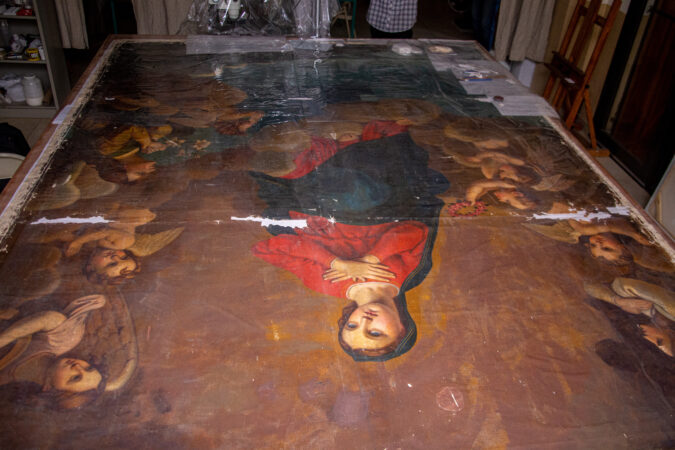
Gaps and deteriorations in the painting attributed to Sully Moreau, « Assumption of Our Lady of Good Help, » 1838, from the Cathedral of Cape. | © David Lorens Mentor/AyiboPost
And in crisis situations, as Erntz Jeudy continues to explain: « Following the example of CSBC and as recommended by the International Centre for the Study of the Preservation and Restoration of Cultural Property (ICCROM) in the aftermath a disaster, our mission consists of ensuring the following, in cases such as the earthquake of August 14 in the South: the analysis of the post-disaster situation to develop an on-site action plan specifically tailored to an emergency situation; assessing the risks and damages caused by the catastrophe to cultural property collections in order to identify and document the damages and prioritize actions to be taken; securing and stabilizing endangered and damaged cultural assets to limit the damages and minimize risks; providing training in cultural first aid for participants from institutions affected by the disaster so that they can take part in the recovery process themselves and do the same in similar cases moving forward. »
The Cultural Conservation Center is the only art restoration center in the country, although there are a few individuals who practice this profession independently. Its team, consisting of four conservator-restorers – Erntz Jeudy, Godson Antoine, Marc-Gérard Estimé, and Richard Rutger – were trained at the National School of Arts (ENARTS) and the Cultural Heritage Management and Conservation Program at Quisqueya University. They have undergone extensive training and internships to enhance their skills in conservation and restoration.
[metaslider id=50910]
In its eight years of existence, CCC-uniQ has taken direct actions for the conservation of Haitian heritage. « For a country so culturally rich and whose material witnesses to its culture are threatened due to multiple agents of deterioration, our actions are far from sufficient. But for such a young conservation center, we have done what is possible with the resources at hand, » explains Jeudy.
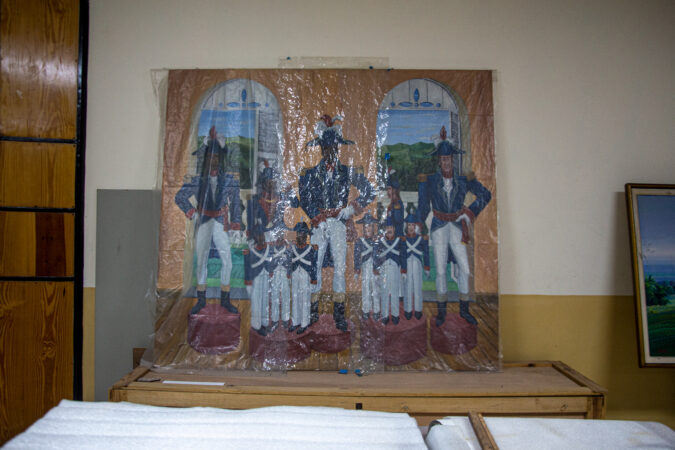
Painting by Édouard Duval-Carrié depicting Haitian Heroes. | © David Lorens Mentor/AyiboPost
Thus, after the earthquake that took place on August 14, 2021, in the South, the Center implemented a recovery project that, according to the restorer, allowed the young people of the city of Les Cayes to once again enjoy the activities of the IPDEC library, and the population of the Camp-Perrin locality to once again benefit from the archives of the Chapel of Saint-Eugène and the Parish of Sainte-Anne. Additionally, KNVA-Sud can now promote Rara in the South as an intangible cultural heritage linked to Vodou.
Read also : Le rara haïtien s’est implanté en République Dominicaine
The country’s security and sociopolitical situation significantly impacts CCC-uniQ’s work, as Erntz Jeudy explains.
« The inability to access certain roads and the stress caused by insecurity; the absence of local suppliers for the products and materials we use » are part of the problem. The restorer also mentions the lack of understanding among cultural actors who « struggle to accept our ethical approach, which involves the obligation to intervene minimally and with respect for the integrity (physical, historical, and aesthetic) of the artworks. »
Despite these difficulties, there exists within the small team of conservator-restorers at the Center, a shared passion for artwork – a feverous drive to keep Haitian pictorial heritage alive and to preserve it for future generations.
We develop an emotional connection with the works that have benefited from our conservation-restoration efforts. So, it’s always difficult for us when their owners come to retrieve them. For instance, we can consider the case of Numa Desroches’ ‘Palais de Sans Souci’ which we restored. Fortunately, we can find solace in another artwork of great importance in our cultural heritage: the ‘Assumption of Our Lady of Good Help’ by Sully Moreau. »
English translation by Sarah Jean.
Cover Image: The four restorers of CCC-uniQ. | © Jean Feguens Regala/AyiboPost
Watch this special episode of our program « Chita Pale, » produced in May 2021, featuring Kesnel Bien Aimé, the sociologist-photographer, as he introduces his work in this field:
Stay in touch with AyiboPost through :
▶ Our Telegram canal : click here
▶ Our WhatsApp Community : click here

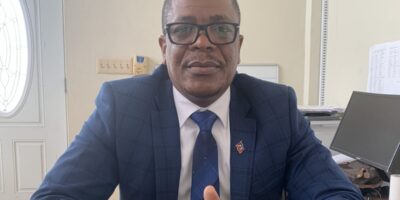
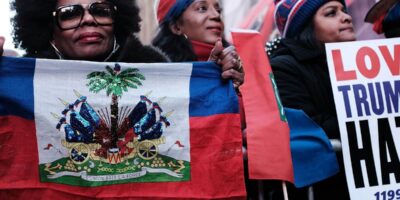
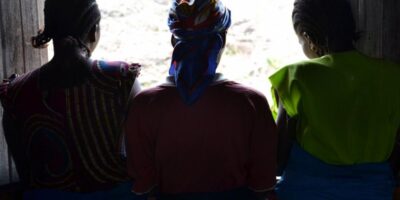



Comments